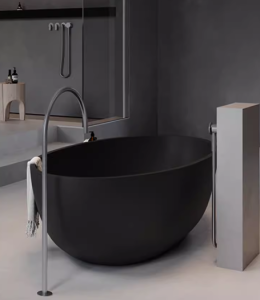Marble bathtubs, with their unique natural texture and unparalleled luxury, have become the iconic element of many high-end homes. However, while many people enjoy the beauty and comfort brought by marble bathtubs, they unknowingly make many maintenance mistakes, causing the bathtub to lose its luster or even suffer irreversible damage. Scientific maintenance techniques are crucial if we like the marble bathtub to remain appealing for a long period. This essay will take you to an in-depth knowledge of the maintenance misunderstandings of marble bathtubs and how to properly maintain them, thereby helping you to better care for this priceless home art.

Ⅰ. Common maintenance misunderstandings of marble bathtubs
1. Use strong acid or strong alkaline cleaners
Many people mistakenly believe that strong acid or strong alkaline cleaners can effectively remove stubborn stains on the bathtub, but for marble bathtubs, this is a fatal mistake. Calcium carbonate makes up most of marble; it will react chemically when it comes across acidic or alkaline materials, corroding the surface, producing stains, colour changes, and perhaps potholes. Since this damage is permanent, be cautious not to use such chemical cleansers when washing a marble bathtub.
2. Frequent use of abrasive cleaners
Although abrasive cleaners can help remove dirt, they are too rough for marble surfaces. Regular use of abrasive cleaners will harm the marble surface, therefore compromising its unique lustre and texture. These little scratches will gather over time and finally degrade the marble surface.
3. Use of inappropriate tools
When cleaning a marble bathtub, many people use hard brushes or steel wool, thinking that this can remove dirt more thoroughly. Actually, this habit will result in major scratches on the marble surface, therefore compromising the smooth feel of the bathtub. The marble surface is rather delicate and calls for soft cleaning brushes or microfiber towels or soft sponges.
4. Neglecting to clean water stains in time
Many people would forget to clean the water stains on the surface in time after using a marble bathtub, assuming that natural air drying is sufficient. Long-term water stains, on the marble surface, will, however, create challenging-to-remove water traces that compromise its beauty. Moreover, elements in the water could enter the small pores of the marble and create persistent stains.
5. Sealing without regular treatment
Many marble bathtub users ignore the importance of regular sealing. One porous item is marble. Liquids and stains can readily seep into it if it is not routinely sealed, therefore creating permanent harm. Sealing the marble bathtub every six to twelve months will help to create a protective film that keeps stains out of reach.

Ⅱ. Scientific maintenance methods for marble bathtubs
1.Choose a mild pH neutral detergent.
Using a low pH neutral detergent is the best option while cleaning a marble bathtub. While keeping the inherent lustre of the marble, this kind of detergent will efficiently remove debris without damaging its surface chemically. Use diluted detergent, apply it to the marble surface, then gently wipe it.
2. Use soft cleaning tools
Soft cleaning products like microfiber towels or soft sponges are advised to help one avoid scratching the marble surface. Wipe lightly rather than vigorously when cleaning to help to eliminate stains and preserve the marble’s flawless surface.
3. Regular sealing
Protecting your marble bathtub mostly depends on regular sealing. The sealant forms a protective film on the marble surface to prevent liquids and stains from penetrating. Sealing every six to twelve months is advised depending on climatic conditions and frequency of use. For optimal effects, make sure the marble surface is dry and clean before sealing.
4. Clean up water stains in time
After each use of the marble bathtub, be sure to clean up the water stains on the surface in time. To prevent water markings on the marble surface from persisting, wipe the water stains with a fresh soft cloth. This little habit helps the marble bathtub to stay glossy and beautiful and to last.
5. Preventive maintenance
Maintaining a marble bathtub calls not only for daily cleaning but also for preventative maintenance. To stop water stains from seeping on the marble surface, for instance, cover the edge of the bathtub with a very absorbent mat; avoid using bath products including dyes in the bathtub to prevent the dye from entering the marble. With careful preventive maintenance, future cleaning and repair issues can be much lessened.
Ⅲ. Precautions for using marble bathtubs
1. Avoid heavy objects
Marble is hard, however it could break or get damaged even from large objects. Thus, keep heavy objects like glass bottles and metal goods off the edge of the marble bathtub. Furthermore, careful usage of the shower equipment placed above the bathtub helps to prevent objects like shower heads dropping on the marble surface.
2. Control temperature changes
Marble is more sensitive to temperature changes, and extreme temperature differences may cause cracks on its surface. Thus, pay close attention to adjusting the water temperature when using a marble bathtub to prevent abruptly injecting overheated or overcooled water. Particularly in the chilly winter, pay closer attention to avoid too strong temperature fluctuations cracking the marble bathtub.
3. Avoid using colored cleaners
Many cleansers include colourants or dyes, which could enter the marble’s pores and stain the stone, therefore altering its appearance. Try to pick transparent and colourless cleaners when selecting cleaning products; steer clear of items with dyes.
4. Check the bathtub regularly
Even if you are very careful in daily use, you still need to check the condition of the marble bathtub regularly to detect and deal with potential problems in time. For instance, find out whether the marble surface has minor fractures or scratches, whether the sealant’s protective layer is whole, etc. Frequent inspections help you prevent more damage and cure issues in time when they first start to show.

Marble bathtubs are works of art in high-end homes, but their beauty and durability cannot be separated from scientific maintenance. You may not only prolong the life of the marble bathtub but also preserve it as brilliant as new by avoiding typical maintenance misunderstandings and using appropriate cleaning and maintenance techniques. The beauty of a marble bathtub comes from your meticulous treatment as much as from its opulent texture. As long as you maintain it carefully, this natural beauty will accompany your life for a long time and bring endless enjoyment.





